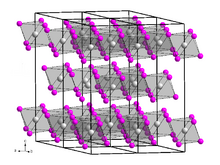Chemistry:Dysprosium(III) iodide
From HandWiki

| |
| Names | |
|---|---|
| Other names
Dysprosium triiodide, triiododysprosium
| |
| Identifiers | |
3D model (JSmol)
|
|
| ChemSpider | |
| EC Number |
|
PubChem CID
|
|
CompTox Dashboard (EPA)
|
|
| |
| |
| Properties | |
| DyI3 | |
| Molar mass | 543.213 g·mol−1 |
| Appearance | yellow-green flaky solid |
| Density | g/cm3 |
| Melting point | 955 °C (1,751 °F; 1,228 K) |
| Boiling point | 1,320 °C (2,410 °F; 1,590 K) |
| soluble | |
| Structure | |
| trigonal | |
| Related compounds | |
Related compounds
|
Ytterbium(III) iodide |
| Hazards | |
| GHS pictograms | 
|
Except where otherwise noted, data are given for materials in their standard state (at 25 °C [77 °F], 100 kPa). | |
| Infobox references | |
Dysprosium(III) iodide is a binary inorganic compound of dysprosium and iodine with the chemical formula DyI3.[1]
Synthesis
Dysprosium(III) iodide can be obtained by reacting dysprosium with iodine.
- 2Dy + 3I → 2DyI
3
- 2Dy + 3I → 2DyI
Dysprosium(III) iodide can be obtained using the effect of mercury diiodide on dysprosium filings:
- 2Dy + 3HgI
2 → 2DyI
3 + 3Hg
- 2Dy + 3HgI
Physical properties
Dysprosium(III) iodide is a hygroscopic yellow-green flaky solid[2] that is soluble in water.[3][4] The compound has a trigonal crystal structure of the bismuth(III) iodide type with the space group R3.
Uses
Dysprosium(III) iodide is used in gas discharge lamps to generate white light.[5]
References
- ↑ "dysprosium triiodide". NIST. https://webbook.nist.gov/cgi/cbook.cgi?ID=C15474632&Units=SI&Mask=FFFF.
- ↑ Macintyre, Jane E. (23 July 1992) (in en). Dictionary of Inorganic Compounds. CRC Press. p. 3117. ISBN 978-0-412-30120-9. https://books.google.com/books?id=9eJvoNCSCRMC&dq=Dysprosium+triiodide&pg=PA3117. Retrieved 5 April 2023.
- ↑ "Dysprosium(III) iodide, ultra dry, 99.99% (REO), Thermo Scientific Chemicals". fishersci.com. https://www.fishersci.com/shop/products/dysprosium-iii-iodide-ultra-dry-99-99-reo-thermo-scientific/AA3569303.
- ↑ "35693 Dysprosium(III) iodide, ultra dry, 99.99% (REO)". Alfa Aesar. https://www.alfa.com/ru/catalog/035693/.
- ↑ Emsley, John (2003) (in en). Nature's Building Blocks: An A-Z Guide to the Elements. Oxford University Press. p. 131. ISBN 978-0-19-850340-8. https://books.google.com/books?id=j-Xu07p3cKwC&pg=PA131. Retrieved 5 April 2023.
| HI | He | ||||||||||||||||
| LiI | BeI2 | BI3 | CI4 | NI3 | I2O4, I2O5, I4O9 |
IF, IF3, IF5, IF7 |
Ne | ||||||||||
| NaI | MgI2 | AlI3 | SiI4 | PI3, P2I4 |
S | ICl, ICl3 |
Ar | ||||||||||
| KI | CaI2 | Sc | TiI4 | VI3 | CrI3 | MnI2 | FeI2 | CoI2 | NiI2 | CuI | ZnI2 | Ga2I6 | GeI2, GeI4 |
AsI3 | Se | IBr | Kr |
| RbI | SrI2 | YI3 | ZrI4 | NbI5 | Mo | Tc | Ru | Rh | Pd | AgI | CdI2 | InI3 | SnI4, SnI2 |
SbI3 | TeI4 | I | Xe |
| CsI | BaI2 | HfI4 | TaI5 | W | Re | Os | Ir | Pt | AuI | Hg2I2, HgI2 |
TlI | PbI2 | BiI3 | Po | AtI | Rn | |
| Fr | RaI2 | Rf | Db | Sg | Bh | Hs | Mt | Ds | Rg | Cn | Nh | Fl | Mc | Lv | Ts | Og | |
| ↓ | |||||||||||||||||
| La | Ce | Pr | Nd | Pm | SmI2 | Eu | Gd | TbI3 | Dy | Ho | Er | Tm | Yb | Lu | |||
| Ac | ThI4 | Pa | UI3, UI4 |
Np | Pu | Am | Cm | Bk | Cf | EsI3 | Fm | Md | No | Lr | |||
 |

